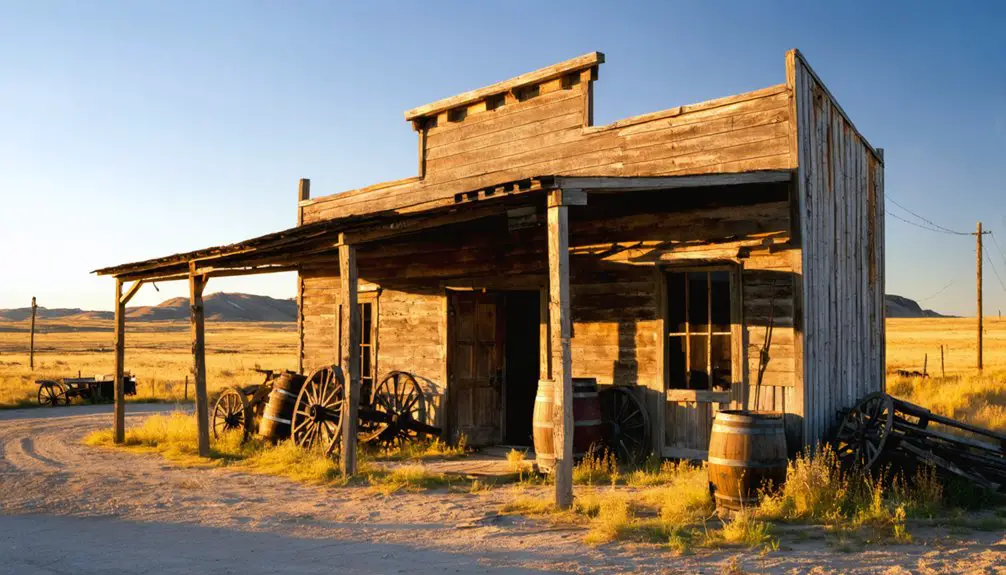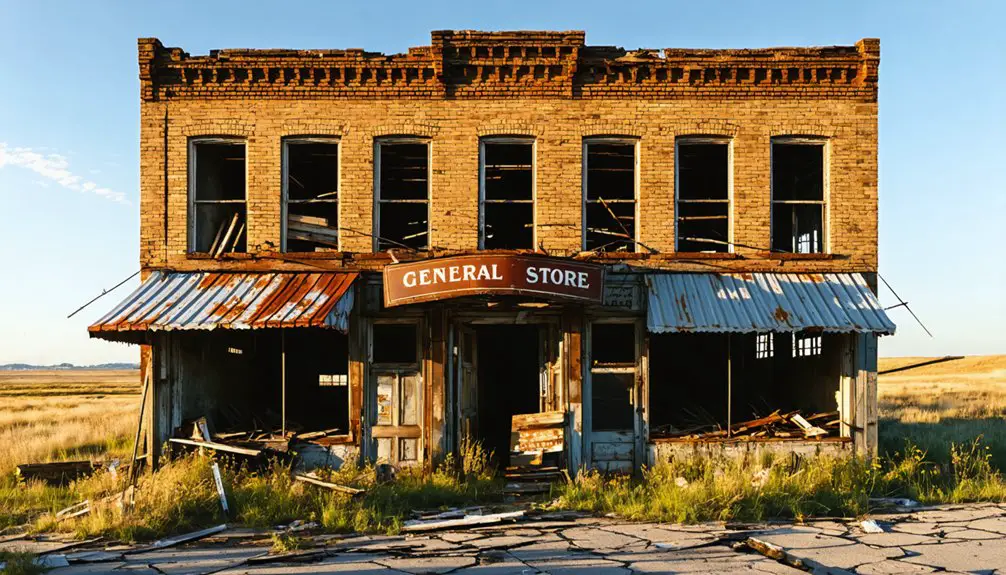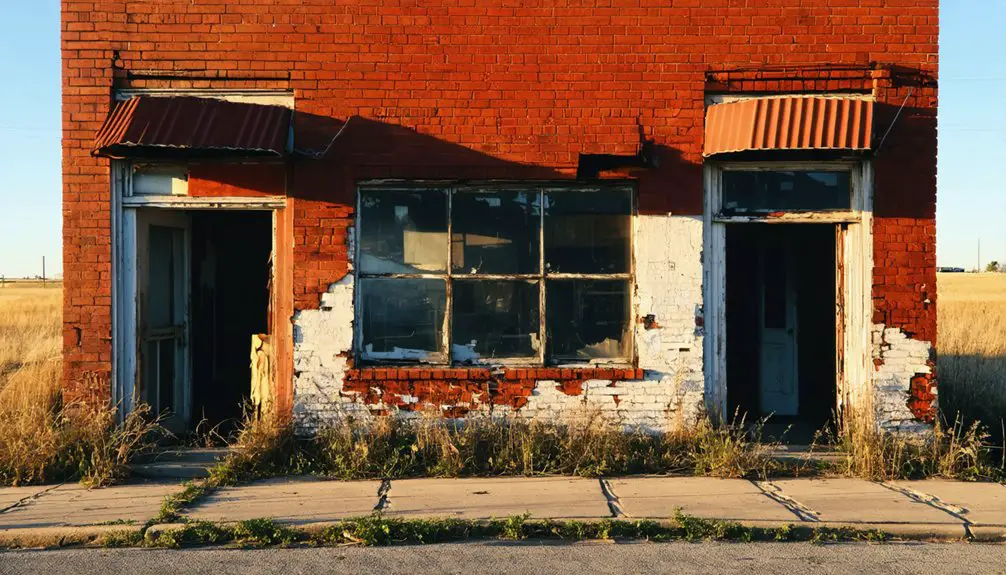You’ll find Empire City‘s remains one mile north of Galena, Kansas, where it emerged as a bustling mining town in 1877 after the West Joplin Lead & Zinc Company discovered valuable mineral deposits. The town’s population exploded to 35,000 during its peak, with Red Hot Street’s saloons and gambling halls defining its Wild West character. After losing a bitter rivalry with Galena and facing declining ore production, Empire City vanished by 1907—leaving behind fascinating tales of lawlessness and prosperity.
Key Takeaways
- Empire City, Kansas originated in 1877 after lead and zinc deposits were discovered, quickly growing to 3,000 residents within months.
- The town flourished as a wild mining community with notorious Red Hot Street, known for saloons, gambling halls, and lawlessness.
- Empire City competed fiercely with neighboring Galena, leading to violent confrontations and the construction of an eight-foot defensive stockade.
- Economic decline began as mining prospects diminished, with Galena’s richer deposits drawing away miners and businesses.
- In 1907, Empire City was annexed by Galena, marking its transformation into a ghost town as residents abandoned the area.
A Mining Boomtown Emerges
When the West Joplin Lead & Zinc Company discovered promising mineral deposits in 1877, they purchased J. Nichols’ 120-acre farm for $7,000, setting the stage for Empire City’s explosive growth.
You’ll find this boomtown’s origins just a mile north of Galena, Kansas, straddling Short Creek.
The company’s mining techniques transformed the landscape as they expanded operations across 580 additional acres. They quickly platted 200 lots, which enthusiastic settlers snatched up that May. Within months, the town’s population reached an astounding three thousand residents.
The economic impact was immediate – by May 25th, a massive multipurpose building housed everything from a saloon to the company office. Business blocks and housing rows sprouted up alongside the mines, and the population surged. Under the leadership of S. L. Cheeney, the newly incorporated city began taking shape as its first mayor.
Local newspapers weren’t exaggerating when they dubbed Empire City the potential “Boss Town of the Southwest.”
Life on Red Hot Street
Violence and vice ruled Red Hot Street, the notorious one-block stretch connecting Empire City and Galena’s main thoroughfares.
You’d find yourself amid a chaotic scene of hastily-built saloons, gambling halls, and brothels like the “Round Top,” “Hickory Tree,” and “Log Cabin.” The nightlife pulsed with music and dancing, drawing a raw mix of miners, gamblers, and drifters into its dens of debauchery. George W. Webb’s arrest demonstrated the fierce rivalry between the two towns.
The vice economy dominated completely, pushing out legitimate businesses as gambling spilled onto the streets. The tension between the cities grew so intense that Galenians built a wooden stockade to block passage in 1877.
With law enforcement turning a blind eye, you’d witness brawls, shootouts, and infamous murders like that of “Tiger Bill.”
The Battle With Neighboring Galena
If you’d visited Empire City in 1877, you’d have witnessed the intense rivalry with neighboring Galena over mining rights and street access.
The conflict reached its peak when Empire City erected an eight-foot-high stockade along Short Creek to prevent residents from moving to Galena’s more prosperous lead fields.
Your travel between the towns would’ve been blocked until August 15th, when a 50-person Galena posse launched a pre-dawn raid to tear down and burn the controversial barrier.
Empire City’s population initially grew faster than Galena’s due to its proximity to mines, but this advantage wouldn’t last long.
The town’s decline became inevitable when it was annexed by Galena in 1907, ending its independence and three-decade existence.
Mining Rights Rivalry
The fierce rivalry between Empire City and Galena erupted in spring 1877, as Empire City’s founders deliberately established their town to compete with neighboring Galena during the region’s lead mining boom.
Mining disputes quickly intensified as Galena’s natural advantage became clear – the richest lead deposits lay beneath their territory.
You’ll find the conflict reached its peak when Empire City built an eight-foot stockade to block access to Columbus Street and Short Creek bridge, asserting their territorial claims.
Galena’s response was swift: fifty citizens formed a posse and burned the wall. While shots were fired, bloodshed remained minimal.
The incident sparked legal battles, including Mayor Webb’s arrest and eventual acquittal.
The rivalry continued until 1907 when Galena finally annexed Empire City.
Street Access Conflicts
Desperate to control local movement and commerce, Empire City’s council passed a contentious resolution on July 25, 1877, ordering construction of an eight-foot-high stockade along the south side of town.
The wall would block Columbus Street and Short Creek bridge, severing crucial connections with neighboring Galena. You’d have seen tensions escalate as street negotiations failed and police protected workers from angry protesters.
When access disputes reached federal authorities over blocked mail routes, Galena’s frustrated citizens took matters into their own hands. The area would later become home to the infamous Ma Staffleback bordello, which added to the region’s notorious reputation in the 1890s.
At 4 a.m. on August 15, a mayor-authorized posse of 50 residents stormed the barrier, tearing it down and setting it ablaze. The surprise attack met little resistance, effectively ending Empire City’s attempt to isolate its rival during the competitive lead mining boom.
Rise and Fall of the Mining Economy
Lead and zinc deposits, known to Native Americans for generations, sparked Empire City’s meteoric rise after white settlers discovered commercial quantities in 1872.
You’ll find the West Joplin Lead & Zinc Company quickly purchased over 600 acres, establishing a company town that sold 200 lots by May 1877.
The area’s economic sustainability peaked when Empire City and rival Galena became one of the world’s richest mining districts, producing over $100 million in ore by 1899.
The combined population soared to 35,000 as railroads facilitated mineral shipments to distant markets.
John Shoe and John McAllen discovered the area’s potential after finding a rich zinc deposit while digging a shaft on Short Creek.
However, with no environmental reclamation planning, the mining economy’s collapse was inevitable.
Wild West Culture and Social Life

You’ll find Empire City’s Wild West culture centered along Red Hot Street, where saloons and gambling halls created a boisterous social hub for the town’s 3,000 residents in 1877.
The street’s notorious reputation came from its high concentration of brothels and gambling operations that frequently spilled onto the sidewalks due to overcrowding. Like the infamous Long Branch Saloon of Dodge City, these establishments became legendary gathering spots for both lawmen and outlaws.
Despite minimal law enforcement, the vibrant social scene thrived with constant activity, though it often erupted in violence between rival establishments and competing towns. Much like the streets of Whiskey Row in Prescott, the establishments drew a mix of colorful characters seeking entertainment and trouble.
Saloons and Gambling Houses
Empire City’s notorious “Red Hot Street” earned its reputation as the beating heart of frontier vice, boasting a dense concentration of saloons, gambling houses, and brothels that dominated the thoroughfare.
As the town’s population swelled to 3,000, these establishments became vital social and economic hubs where miners, travelers, and professional gamblers mingled freely in a largely lawless environment.
- Professional gamblers rose to prominence as influential local figures
- Gaming activities spilled onto the streets due to high demand
- Revenue from gambling often exceeded legitimate merchant earnings
- Venues operated with minimal restrictions due to lack of formal law enforcement
- The saloons culture created an informal economy that shaped the town’s development and identity
Violence Between Rival Towns
While the lawless atmosphere of Empire City’s Red Hot Street fostered internal conflicts, the town’s most dramatic violence erupted through bitter rivalries with neighboring settlements.
You’d have witnessed town rivalries escalate into deadly confrontations as communities fought viciously for economic dominance, particularly over railroad access and cattle trade routes.
These violent encounters often played out through organized brawls, ambushes, and public shootouts between opposing factions.
With overwhelmed law enforcement, vigilante justice took hold as towns hired gunmen to protect their interests.
Local desperados and outlaws further inflamed these conflicts, targeting rival communities while operating under loose legal constraints.
The socioeconomic competition between settlements created a powder keg of tension that frequently exploded into bloodshed on Kansas’s untamed frontier.
Red Hot Street Life
Life on Red Hot Street pulsed with raw energy as saloons, gambling halls, and dance venues created a vibrant social hub in Empire City.
You’d find yourself swept into a world where traveling theater troupes brought cultural flair while poker games tested fortunes and nerves.
The mix of cowboys, gamblers, and painted ladies made every evening an adventure in saloon entertainment, though you’d need to watch your back after winning at cards.
- Thrilling poker games where fortunes changed hands nightly
- Theater performances and can-can dancers bringing artistic excitement
- High-stakes gambling risks that could turn deadly
- Painted ladies and brothels adding to the town’s wild reputation
- Frequent brawls and disorder fueled by flowing whiskey
The Town’s Gradual Abandonment

As mining prospects dwindled in the late 1800s, the once-bustling Empire City faced a steady exodus of its residents.
You’d have witnessed a dramatic community decline as nearby Galena’s richer lead deposits drew miners and businesses away. The town’s economic shifts became apparent when saloons and gambling halls that once defined Red Hot Street began closing their doors.
The lack of infrastructure improvements, particularly railroads, sealed Empire City’s fate.
You couldn’t find the same vibrant social scene that had characterized the town’s heyday, as employment opportunities vanished and families moved elsewhere. By the 1880s, the inadequate planning for long-term growth and failure to diversify beyond mining left Empire City struggling to maintain basic services, accelerating its transformation into a ghost town.
Legacy of a Kansas Mining Era
When Kansas mining reached its zenith in the early 1900s, you’d have seen an unprecedented boom across multiple mineral industries, from coal to lead and zinc.
Mining technology transformed the landscape around Empire City and neighboring towns, where room-and-pillar systems and informal shaft digging dominated the scene. You can still trace the economic shifts that shaped this region’s destiny, from its peak production of 7.5 million tons of coal in 1917 to the eventual decline by the 1930s.
Kansas mining’s golden age saw peak coal production of 7.5 million tons before economic forces drove the industry into decline by the 1930s.
- Cherokee County alone yielded 2.9 million tons of zinc and 700,000 tons of lead
- Immigrants flocked to boomtowns, swelling populations to thousands
- Underground mining began in 1874, using innovative extraction methods
- Salt mining near Hutchinson made Kansas the nation’s third-largest producer
- The industry’s decline left a legacy of abandoned shafts and transformed communities
Frequently Asked Questions
Are There Any Remaining Original Buildings Still Standing in Empire City Today?
You’ll find a few scattered original structures, mostly deteriorating homes, still standing today without any formal historical preservation efforts, but there’s no intact commercial district or public buildings remaining.
What Happened to the Residents When Empire City Was Abandoned?
You’ll find most residents joined the residential migration to nearby Galena, where richer ore deposits promised better opportunities. Others scattered across western mining towns during this community displacement from 1880-1913.
Did Any Famous Outlaws or Historical Figures Visit Empire City?
You won’t find any confirmed notable visitors or famous outlaws in Empire City’s history. While local outlaw legends exist, there’s no historical evidence of well-known figures ever visiting this Kansas mining town.
Were There Any Major Natural Disasters That Affected Empire City?
You won’t find historical records of any major natural disasters impacting the town. While Kansas faced its share of severe weather, there’s no evidence of disasters affecting Empire City’s decline.
What Artifacts From Empire City Have Been Preserved in Museums?
You won’t find many documented Empire City artifacts in museums today. Due to limited preservation efforts and poor documentation, it’s unclear which specific items have survived in museum collections.
References
- https://www.legendsofamerica.com/ks-empirecity/
- https://www.hhhistory.com/2019/05/ghost-towns-of-kansas.html
- https://www.youtube.com/watch?v=alC1wDdSVvg
- https://www.pinterest.com/pin/422212533787354431/
- https://legendsofkansas.com/kansas-ghost-town-list/
- https://www.kancoll.org/books/cutler/cherokee/cherokee-co-p13.html
- https://www.legendsofamerica.com/ks-galena/
- https://kansassampler.org/8wondersofkansas-history/lead-and-zinc-mining-baxter-springs-and-galena-museums
- http://genealogytrails.com/kan/cherokee/galenahistory.html
- https://www.hmdb.org/m.asp?m=161630



